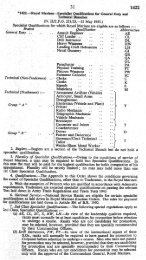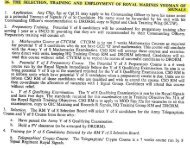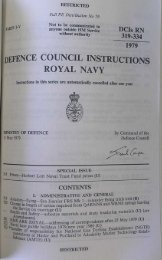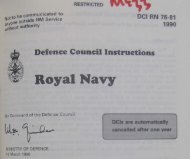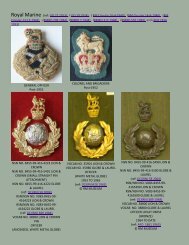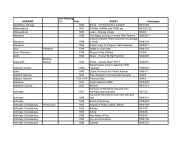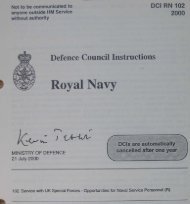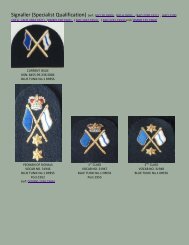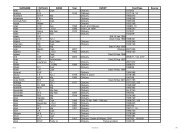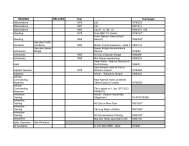Warrant Officer by Major Alastair Donald RM - Royal Marines
Warrant Officer by Major Alastair Donald RM - Royal Marines
Warrant Officer by Major Alastair Donald RM - Royal Marines
Create successful ePaper yourself
Turn your PDF publications into a flip-book with our unique Google optimized e-Paper software.
1 4 March, 2011<br />
On 1st April 1999 the use of the term “SD <strong>Officer</strong>” ceased and was replaced <strong>by</strong> the “Senior Corps<br />
Commission Candidates” scheme. This is the most recent development in the long history of the<br />
provision of opportunities for promotion to warrant or commissioned officer status from the ranks.<br />
WARRANT OFFICERS IN THE ROYAL MARINES<br />
and their promotion ladder<br />
<strong>by</strong> <strong>Major</strong> <strong>Alastair</strong> <strong>Donald</strong> <strong>RM</strong><br />
From a military point of view, a commission is a document authorising the holder to perform duties in the service of the<br />
State. They are granted <strong>by</strong> or on behalf of the sovereign and the recipient is ranked as an officer 1 . A warrant is a<br />
document which is signed <strong>by</strong> a person authorised to issue warrants. In the case of the <strong>Royal</strong> Navy and <strong>Royal</strong> <strong>Marines</strong> the<br />
sovereign delegated such authority to issue warrants to the Board of Admiralty. A warrant officer therefore received a<br />
paper signed <strong>by</strong> someone delegated to do so <strong>by</strong> the Board of Admiralty.<br />
To understand fully the position of <strong>Warrant</strong> <strong>Officer</strong>s in the <strong>Royal</strong> <strong>Marines</strong> prior to 1949, it is first necessary to look at the<br />
historical background to <strong>Warrant</strong> <strong>Officer</strong>s in the <strong>Royal</strong> Navy.<br />
In the <strong>Royal</strong> Navy, from the seventeenth to the start of the twentieth century officers “fell into several overlapping and<br />
often ill-defined groups” 2 . In simple terms, there were commissioned officers and warrant officers. The latter had the<br />
standing of petty officers, but were distinguished from them <strong>by</strong> being appointed <strong>by</strong> warrant rather than being rated <strong>by</strong><br />
their Captains. In the early part of the nineteenth century there were three categories of warrant officers in the Navy,<br />
Boatswains, Gunners, and Carpenters; Engineers were added in 1837. Later in the century warrant officers were given an<br />
opportunity to advance to commissioned rank. In keeping with the pace of technical change, over the years there was a<br />
large increase in the number of specialist categories and new warrant ranks were created for these branches. By 1945<br />
there were warrant officers in twenty-four different branches in the <strong>Royal</strong> Navy.<br />
<strong>Warrant</strong> rank was introduced in the <strong>Royal</strong> <strong>Marines</strong> in 1881 3 , when 8 Sergeant-<strong>Major</strong>s (1 <strong>RM</strong>A; 6 <strong>RM</strong>LI; 1 <strong>RM</strong>LI<br />
supernumerary with an Army Volunteer Battalion), 8 Superintending Clerks (2 <strong>RM</strong>A; 6 <strong>RM</strong>LI), 4 Bandmasters 4 (1<br />
<strong>RM</strong>A; 3 <strong>RM</strong>LI) and 11 Schoolmasters (2 <strong>RM</strong>A; 9 <strong>RM</strong>LI) all received their <strong>Warrant</strong>s dated 1 July that year. At the <strong>Royal</strong><br />
Naval School of Music, the March 1904 Navy List shows two <strong>Warrant</strong> <strong>Officer</strong>s, a Musical Director (Franklin - holding<br />
an Army <strong>Warrant</strong> dated 5 Jan 1900) and a Chief Bandmaster <strong>RM</strong> (Lidiard, with a seniority of 22 Jul 1903); the January<br />
1905 list shows 3 Chief Bandmasters <strong>RM</strong> and the January 1911 list has 8 Bandmasters <strong>RM</strong>, the ‘Chief’ having been<br />
dropped, (In this list Franklin is shown as a 2/Lieutenant <strong>RM</strong>LI with a seniority of 13 Mar 1901). In 1910 20 Gunnery<br />
Sergeant <strong>Major</strong>s were to be appointed 5 and <strong>by</strong> the following year there were 4 <strong>RM</strong>A and 14 <strong>RM</strong>LI (5 Chatham; 5<br />
Portsmouth; 4 Plymouth) 6 . However at sea there was confusion between them and the Senior NCO of the <strong>RM</strong><br />
Detachment, who was always known as the Sergeant <strong>Major</strong> and so in 1912 7 their title was changed to <strong>Royal</strong> Marine<br />
Gunners.<br />
In 1916 the rank of <strong>Warrant</strong> <strong>Officer</strong> Class 2, similar to the Army, was introduced into the <strong>Royal</strong> <strong>Marines</strong>. Existing<br />
<strong>Warrant</strong> <strong>Officer</strong>s, (Sergeant <strong>Major</strong>s, Bandmasters, Superintending Clerks and Schoolmasters [WO]), serving on 27<br />
August 1915 were then classed as WO <strong>RM</strong> Class 1, also similar to the Army. WO <strong>RM</strong> Class 2 were Quartermaster<br />
Sergeants, Quartermaster Sergeant Instructors and Schoolmasters [NCOs] and Colour Sergeants, who were appointed as<br />
Company Sergeants were also included as WO2s and titled Company Sergeant-<strong>Major</strong> 8 . Only WO1s were included in the<br />
Navy List 9 . In the November 1918 Navy List ‘<strong>Warrant</strong> <strong>Officer</strong>s, <strong>Royal</strong> <strong>Marines</strong>, Class 1’ were listed as Sergeant <strong>Major</strong>s,<br />
Superintending Clerks, Bandmasters, Chief Gunners and <strong>RM</strong> Gunners, Chief Schoolmasters and Schoolmasters. By<br />
January 1920 they were all shown simply as ‘<strong>Warrant</strong> <strong>Officer</strong>s’ again. They wore no badge of rank. Their next promotion<br />
was to Commissioned <strong>RM</strong> Gunners, Commissioned Sergeant <strong>Major</strong>s, Commissioned Superintending Clerks and<br />
Commissioned Bandmasters, and <strong>by</strong> an Order-in-Council dated 22 January 1920 the term ‘Commissioned <strong>Warrant</strong><br />
<strong>Officer</strong>s’ was abolished and replaced <strong>by</strong> ‘Commissioned <strong>Officer</strong>s from <strong>Warrant</strong> Rank’. Their badge of rank was a single<br />
star on their shoulder 10 .<br />
In addition to Commissioned <strong>Officer</strong>s from <strong>Warrant</strong> rank in the RN and <strong>RM</strong>, <strong>Warrant</strong> <strong>Officer</strong>s were also entitled to be<br />
saluted <strong>by</strong> Chiefs and Petty <strong>Officer</strong>s, NCOs, ratings and other ranks 11 .<br />
By an Order-in-Council dated 26 July 1926 no further appointments were to be made to <strong>Royal</strong> Marine Gunner and the<br />
title would no longer exist, but twelve years later it was reintroduced. 12
2 4 March, 2011<br />
By an Order-in-Council of 2 February 1937, the junior Sergeant <strong>Major</strong> in each Division became equivalent to an<br />
Army <strong>Warrant</strong> <strong>Officer</strong> Class 1. He was to live in the Sergeants Mess and wear the same uniform as a Staff Sergeant, but<br />
with the badge of rank of the <strong>Royal</strong> Arms. In fact he was dressed the same as a WO1 today, wearing a Sam Browne belt<br />
and carried an officers’ pattern sword. After two years these Sergeants <strong>Major</strong>s would be eligible for promotion to Staff<br />
Sergeant <strong>Major</strong>, having the seniority as a <strong>Warrant</strong> <strong>Officer</strong> from the date they were promoted Sergeant <strong>Major</strong>. Their<br />
service as a Sergeant <strong>Major</strong> would also count as for warrant rank. This change almost certainly came about due to the<br />
Battalion formed for London Duties in 1935, when the Regimental Sergeant <strong>Major</strong> of the Coldstream Guards was<br />
required to salute the Sergeant <strong>Major</strong> of the <strong>RM</strong> Battalion, Sergeant <strong>Major</strong> E H F Bonnett, the latter being a <strong>Royal</strong><br />
<strong>Marines</strong> <strong>Warrant</strong> <strong>Officer</strong> 13 .<br />
This is perhaps an opportunity to emphasise that Staff Sergeants at that time should not be confused with ‘Sergeants on<br />
the Staff’ at the Divisions. The latter were Colour Sergeants or Sergeants in staff appointments at each of the Divisions;<br />
these were Provost Sergeant, Cook Sergeant, Hospital Sergeant, Armourer Sergeant and Band Sergeant. They wore a<br />
leather sword belt, a Senior NCO’s cap badge and their rank badge was three inverted chevrons on the right cuff; above<br />
the chevrons the Hospital Sergeant had a red cross on a circular white background, the Armourer Sergeant had crossed<br />
hammer and pincers and the Band Sergeant wore a <strong>Royal</strong> Academy style lyre. The only survivor dressed in this manner<br />
today is the Provost Sergeant. After 1950 the Band Sergeants of the old Divisional Bands became Bandmasters, but still<br />
wore the Divisional Band Sergeant’s badge of rank; Lieutenant Colonel Graham Hoskins being the last one to wear this<br />
badge, when the Bandmaster of the Portsmouth Group Band until 1968.<br />
In the March 1940 Navy List a Commissioned Master Tailor and <strong>Warrant</strong> Master Tailors are included 14 . In this list<br />
Schoolmasters were shown as a Chief Schoolmaster (to rank as Captain), Headmasters and Schoolmasters (both as<br />
Commissioned <strong>Warrant</strong> <strong>Officer</strong>s). With the re-formation of the <strong>Royal</strong> Marine Engineers during the Second World War,<br />
three Temporary <strong>Warrant</strong> <strong>Officer</strong>s <strong>RM</strong>E appeared in the Navy List, a General Works Foreman, a Quay Foreman and<br />
another titled ‘Mechanical’. In line with the RN a <strong>Warrant</strong> Recruiter was included in 1942. Up until 1943 <strong>Warrant</strong><br />
<strong>Officer</strong>s wore no badges of rank, but early that year they were granted a badge on their shoulder of a small ‘WO’<br />
surrounded <strong>by</strong> a laurel wreath 15 , worsted khaki on khaki for battledress and gold on blue for blue uniform.<br />
After becoming a Commissioned <strong>Officer</strong> from <strong>Warrant</strong> Rank, their next promotion was to Lieutenant (Quartermaster),<br />
then to Captain (QM), <strong>Major</strong> (QM) and finally Lieutenant Colonel(QM). There was a Lieutenant Colonel (QM) on the<br />
staff in London during the Second World War. Dependant on their appointment, Commissioned Bandmasters at the<br />
RNSM were either promoted to Lieutenants (Quartermaster) followed <strong>by</strong> Captain (Quartermaster) or to Lieutenants<br />
(Musical Director) and then later be promoted Captain (Musical Director).<br />
On 5 April 1949 16 , in the <strong>Royal</strong> Navy and <strong>Royal</strong> <strong>Marines</strong>, the generic title “<strong>Warrant</strong> <strong>Officer</strong>” was replaced <strong>by</strong> “Branch<br />
<strong>Officer</strong>” and they were to be appointed <strong>by</strong> commission and not warrant. <strong>Warrant</strong> <strong>Officer</strong>s became ‘Commissioned<br />
<strong>Officer</strong>s’ and the previous Commissioned <strong>Officer</strong>s from <strong>Warrant</strong> rank became ‘Senior Commissioned <strong>Officer</strong>s’. This<br />
was a significant change, <strong>Warrant</strong> <strong>Officer</strong>s’ messes were closed and, now that they were commissioned, they were<br />
received into the Wardroom or <strong>Officer</strong>s’ Mess. A minor change was that in both the senior and junior grades, Staff<br />
Sergeant-<strong>Major</strong>s and Superintending Clerks were combined to become Senior Commissioned Sergeants-<strong>Major</strong>s and<br />
Commissioned Sergeant-<strong>Major</strong>s respectively. The senior grades wore a large star on their shoulder, whilst the junior<br />
grades wore a small star. This was now very much in line with the thick and thin stripes which had been worn <strong>by</strong><br />
equivalent RN officers and warrant officers since the second half of the 19 th century 17 . As before, their further promotion<br />
was to Lieutenant (QM) and then to Captain (QM) etc.<br />
Old Title<br />
Staff Sergeant <strong>Major</strong> }<br />
Superintending Clerk}<br />
Commissioned Staff Sergeant <strong>Major</strong> }<br />
Commissioned Superintending Clerk }<br />
<strong>RM</strong> Gunner<br />
Commissioned <strong>RM</strong> Gunner<br />
Master Tailor<br />
Commissioned Master Tailor<br />
Bandmaster (WO) <strong>RM</strong> Band<br />
Commissioned Bandmaster <strong>RM</strong> Band<br />
<strong>Warrant</strong> Recruiter <strong>RM</strong><br />
New Title<br />
Commissioned Sergeant <strong>Major</strong><br />
Senior Commissioned Sergeant <strong>Major</strong><br />
Commissioned <strong>RM</strong> Gunner<br />
Senior Commissioned <strong>RM</strong> Gunner<br />
Commissioned Master Tailor<br />
Senior Commissioned Master Tailor<br />
Commissioned Bandmaster<br />
Senior Commissioned Bandmaster<br />
Commissioned Recruiter <strong>RM</strong>
3 4 March, 2011<br />
On 1 January 1957 Branch <strong>Officer</strong>s were retitled Special Duties List <strong>Officer</strong>s 18 . The Order–in-Council, which was in fact<br />
dated 15 February 1957, directed the following changes:<br />
Commissioned Sergeant <strong>Major</strong>s<br />
Senior Commissioned Sergeant <strong>Major</strong>s<br />
became 2 nd Lieutenants (QM)<br />
became Lieutenants (QM)<br />
Commissioned <strong>RM</strong> Gunners<br />
Senior Commissioned <strong>RM</strong> Gunners<br />
became 2 nd Lieutenants (SD)<br />
became Lieutenants (SD)<br />
Lieutenants (QM) }<br />
Captains (QM) }<br />
became Captains (QM)<br />
There was no change in the rank of <strong>Major</strong>s (QM)<br />
Band <strong>Officer</strong>s<br />
Commissioned Bandmasters<br />
Senior Commissioned Bandmasters<br />
became 2 nd Lieutenants (BM)<br />
became Lieutenants (BM)<br />
Lieutenants } became Captains (BM)<br />
Captains }<br />
<strong>Major</strong><br />
became <strong>Major</strong> (BM)<br />
There was no change in the title of Recruiting <strong>Officer</strong>s, but they were treated as 2 nd Lieutenants (SD).<br />
Soon afterwards ‘QM’ was abolished as part of a rank title and these officers all became ‘SD’. Band <strong>Officer</strong>s became<br />
‘SD(B)’ and for a short time were known as Bandmaster 2 nd Lieutenants, similarly Bandmaster Lieutenants and<br />
Bandmaster Captains. When the Commandant of the <strong>RM</strong> School of Music, Colonel ‘Bertie’ Lumsden announced this<br />
change in title to the <strong>Officer</strong>s at a special meeting in the Mess, he suggested that perhaps therefore the Principal Director<br />
of Music would be known as Bandmaster Lieutenant Colonel Dunn – the latter was not amused!<br />
The badges of rank of SD <strong>Officer</strong>s were as for General List <strong>Officer</strong>s, 2nd Lieutenants (SD) wore a single normal sized<br />
star on the shoulder and Lieutenants (SD) had two stars, etc.<br />
On 1 July 1972, under the provisions of the Armed Forces Act 1971, the ranks of <strong>Warrant</strong> <strong>Officer</strong> Class 1 and Class 2<br />
were reintroduced into the Corps, in place of the ranks of Regimental Sergeant <strong>Major</strong> and Quartermaster Sergeant<br />
respectively. They were to be addressed as ‘Sir’ <strong>by</strong> those junior to them, as ‘Mr’ <strong>by</strong> those senior and their warrants<br />
signed <strong>by</strong> the Secretary of State for Defence. The terms RSM, RQMS and Company Sergeant <strong>Major</strong> are now used as<br />
titles of appointments held <strong>by</strong> <strong>Warrant</strong> <strong>Officer</strong>s 19 . In the <strong>RM</strong> Band Service, which in 1979 absorbed the Bugler Branch of<br />
the Corps, the ranks are WO1 (Bandmaster), WO1 (Bugler), WO2 (Bandmaster) and WO2 (Bugler).<br />
The Senior Corps Commission Candidate scheme is now the method <strong>by</strong> which suitably qualified other ranks, aged<br />
between 26 and 46, can obtain a commission in the Corps. On passing the Admiralty Interview Board and final selection<br />
they become a Staff <strong>Officer</strong> (Late Entry) [SO(LE)], or in the case of the Band Service, SO(LE)(BS).
Notes (including Sources)<br />
4 4 March, 2011<br />
There seems to have been very little written about this subject and the author would be very pleased to hear from any<br />
member who can add anything to this article. Additional information can then be published, either in THE SHEET<br />
ANCHOR or the Quarterly Newsletter, and a more complete edition placed in the archives in the Museum, thus making<br />
the information available to future researchers more complete. The author has it in mind to prepare a follow up article on<br />
‘The Dress of <strong>Royal</strong> <strong>Marines</strong> <strong>Warrant</strong> <strong>Officer</strong>s’ and would particularly welcome details on that subject.<br />
1<br />
2<br />
3<br />
4<br />
5<br />
6<br />
7<br />
8<br />
9<br />
10<br />
11<br />
12<br />
13<br />
14<br />
15<br />
16<br />
17<br />
18<br />
19<br />
Military Origins <strong>by</strong> Maj L L Gordon (Kay & Ward 1971)<br />
Naval Records for Genealogists <strong>by</strong> N A M Rodger (PRO 1988)<br />
Order-in-Council dated 29 Nov 1881 [see <strong>Royal</strong> Marine Records (1837-1914) General Sir H E Blumberg (<strong>RM</strong>HS SP No 5 p 24)]<br />
These were the Bandmasters of the Divisional Bands. Later they were Directors<br />
of Music.<br />
O-in-C 7 Nov 1910<br />
Contemporary Navy List<br />
O-in-C 29 Feb 1912<br />
The Globe and Laurel 1916 pp 23 & 43.<br />
In common with the Army where only WO1s were included in the Army List.<br />
There is no mention in the Apr 1920 Appx to the Navy List, but the Jan 1921 list includes “One Star”.<br />
Although in KR&AI(1943) and BR 1834(49), RN Handbook of Parade Training, under ‘Saluting’, <strong>Warrant</strong> <strong>Officer</strong>s are not mentioned, the<br />
Manual of Seamanship (1937) states “The term ‘officer’ includes all Commissioned <strong>Officer</strong>s, <strong>Warrant</strong> <strong>Officer</strong>s and subordinate officers* of<br />
the <strong>Royal</strong> Navy and corresponding ranks in the other services”. [*Midshipmen and Cadets].<br />
O-in-C 4 Nov 1938<br />
Letter from <strong>Major</strong> J P Synott BEM <strong>RM</strong> to the author 17 Mar 2000.<br />
The Commissioned Master Tailor had a seniority of 1 Oct 1930, presumably to ‘insert’ him, perhaps <strong>by</strong> age, into the appropriate position in<br />
the <strong>Warrant</strong> <strong>Officer</strong>s’ Mess. The seniority of the <strong>Warrant</strong> Master Tailors was about 1931.<br />
The Jun 1942 Appx to the Navy List shows “No badges of rank”, but the Jun 1943 Appx shows “Letters ‘WO’ in a Wreath”.<br />
The O-in-C was in fact dated 28 Oct 1949.<br />
Badges and Insignia of the British Armed Services [The <strong>Royal</strong> Navy <strong>by</strong> Cdr W E May RN](pub Adam & Charles Black, 1974) pages 16 &<br />
17.<br />
AFOs 1 & 555/56<br />
The Globe & Laurel 1972 p195.



